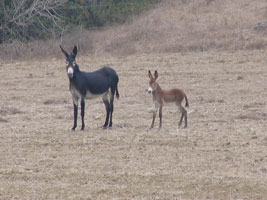Karpas (Karpaz) Peninsula - Touring

The Turks, ever since Sultan Selim first took a fancy to "the rock called Cyprus", have regarded the island as an extension of Anatolia. The long tapering peninsula that reached up to the northeast was described by Churchill as "the dagger which points at the soft underbelly of Turkey". If you choose to see in the landmass of Cyprus the shape of an oblong frying pan, you could choose to see in the Karpas the shape of the panhandle. Viewed this way rather than as a dagger, the handle is conveniently turned towards Turkey, the master who can seize it and take control.
The peninsula falls into three distinct sections: first, from the fishing village of Bošaz to Ziyamet, the least interesting section, forming a kind of transitional zone from the mainland; next, from Ziyamet to Dipkarpaz, scenically much prettier with smaller roads and more contours, this section also has the much publicised Kanakaria church and the early Ayia Trias basilica with its mosaic floor; and finally there is the section beyond Dipkarpaz, definitely the most rewarding stretch, with the northern fork to Ayios Philon and Aphendrika, and the southern fork to the Apostolos Andreas Monastery and Kastros at the very tip. In an ideal world, this section would warrant an entire day in itself, with time to enjoy one of the many deserted beaches, something that is best achieved by spending the night at one of the hotels along here.
Those who can devote only a day to the Karpas should head out beyond Dipkarpaz to Ayios Philon and Aphendrika, then drive on for lunch at the Blue Sea Hotel and take a quick look at the Apostolos Andreas Monastery. On the way back, call in at Ayia Trias in the Greek village of Sipahi. Kanakaria church is kept locked, and the key has to be extracted from the village muhtar or headman, so that is best left for an occasion with plenty of time. There are many other minor churches and sites, and the more leisured visitor can take his/her pick from the following itinerary.


